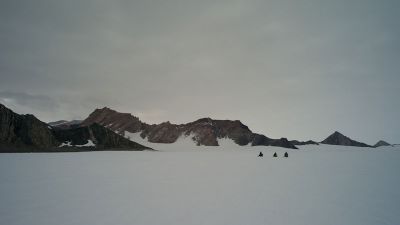
Live from Antarctica: Monday 26 January
Beware Lady Antarctica, for when she smiles, she bares her teeth. And sure enough, Antarctica has indeed shown us her teeth. And what fangs they are!
Yesterday being Sunday, and the day for thinking of things other than toil, we decided to take a walk up on the Gunestadbreen to prepare next season's scientific activity with JARE. A group of us, six in all, packed our thermoses, a little chocolate, crampons, rope, cameras and so forth, donned our space suits, filled up the skidoos, and headed for the plateau. The weather started off very fine, but the dark line of clouds which had been hanging to the North for the last five days, ominously began to approach.
We continued up past Teltet, and took a right towards Vengen, past the entrance of the Duboisbreen, into a glacial valley which harbours a nasty patch of crevasses, where a blue ice zone falls towards the elongated windscoop. We admired the fault zones and the ancient rocks of Vengen, juxtaposed against the younger masses of Wideroefjellet in the background, and gazed in awe at the giant seracs hanging off the flanks of the ice blasted green walls, while gingerly navigating the barely visible crevasses, one at a time. Alain's advice is simple. "When in doubt accelerate". Doubt being a constant companion, I was hard put to keep my place in the line.
After several hours of climbing, we emerged on the plateau and found ourselves a breezy little vantage point where a cairn was duly built to mark our passage. No-one has been here since Alain and Dixie climbed the Gunnestad 10 years ago, on their way south. We marvelled silently at their strength and stubborness, in dragging themselves and their heavy sledges up the climb we had just accomplished by the miracle of iron horsepower. As he gazes southwards, Alain's eyes are focussed on the past, and he barely seems to notice we are there. It must have been an intensely marking experience.
The cold barely dented our composure in our warm suits (-17°C, with a windchill taking us to -30°C). That is, of course, until a little logistical difficulty arises. Answering the call of nature with ease and elegance is not a given to all in a space suit. One hesitates before drinking warm tea knowing the consequences which will present themselves shortly after.
The clouds had by now moved further inland and the sky was completely overcast. The decision was taken not to be tempted by the meteorite fields which enticingly beckoned to the East, but to head back as rapidly as possible. Going downhill should be simple. Alain makes a passage through the glacier, while Benoit, who is also a licensed mountain guide, brings up the rear. We make good time at first, but the visibility is falling fast. Soon it is impossible to make out Alain's tracks as the overhead clouds fuse the sky and the Earth into one white mass. We bunch up together to make sure that nobody strays off-course, and we inch forward glimpsing occasionally the deep blue hues of a hidden crevasse made visible by a passing track. We climb out of the valley and head for a raised vantage point to see the way ahead. In the distance are small pinpoints of light. The JARE team of geologists is heading back to their camp near Teltet. We cross them on the way back to Utsteinen, and exchange formal handshakes and greetings. Days here are made up of pure surrealism.
Heading back to Utsteinen, we have a long approach during which to lovingly admire the station on the ridge in the rapidly failing light. But the storm has closed in. The driving snow and a high wind make it impossible to spend too long gazing at our extraterrestrial bijou. We put the snow mobiles to bed and do a quick check of camp to make sure that everyone is safely back and that all hatches are battened ready for the storm.
The wind gradually increases in force all night long, and by morning visibility is so reduced, that we have to install special ropes to allow the teams to get to the station from base camp, in visibility that is quickly approaching zero. You have to hand it to the guys - everyone goes to work without a murmur, with only the tips of their noses showing between their goggles and their jackets.
Today, satellite connections are very unstable. We have managed to pass a few short messages via Iridium. The bad weather is expected to last until Thursday which doesn't give us much hope for the next flight arriving on time. The scientists (microbiologists, and meteorologists) were expected here tomorrow, but it is unlikely that we will see them until at least Thursday. More to the point, on the next flight is a deep fryer. Finally, the Belgians will be reunited with their beloved "frites belges".
Next time, I will recount how we installed the science platform into the granite of the North Side of the ridge, while assailed by strong winds.
Nighat Amin
Picture: Sunday Ballad - © International Polar Foundation
